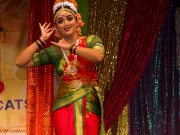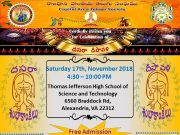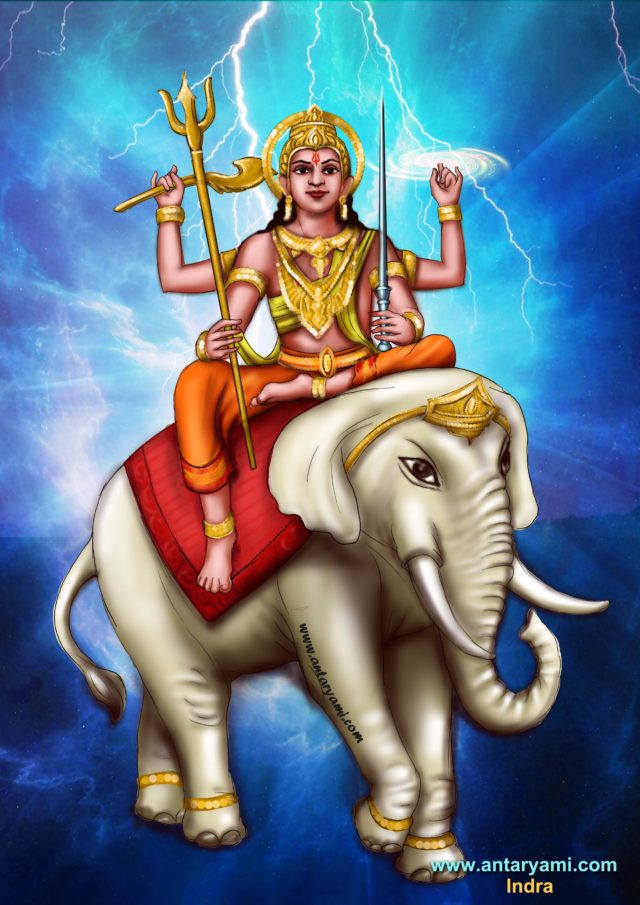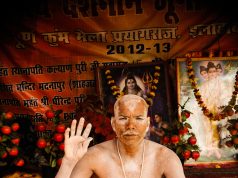Who Is The Hindu God, Lord Indra?
Lord Indra is regarded as one of the most powerful Gods in the ancient Vedic hymns of the Rig Veda. In later myths his supremacy is overshadowed by Vishnu and Shiva. However, Indra is still revered as the King of the Gods and holds an important position in the Hindu pantheon. The only Gods that are above Indra are the Trimurti. But the God of the heavens has Supreme rule over every other God and possesses a powerful weapon known as the vajra.
Indra is the defender of mankind and in Hindu mythology is often found pitted in battle against asuras – demons. On a symbolic level, the demons are the dark passengers of human nature, the habitual thoughts and negative attitudes that lead us astray. Is it not true that we are all possessed by demons? The same is true of the gods, and each represents an aspect of human nature. In essence, mankind is part god and part man, higher consciousness and lower consciousness. Indra represents an aspect of our higher conscious, but as we find in the legends of the warrior king, he sometimes loses control of the heavens and has to ward off demons.
The symbolic meaning of Indra
In the earliest myths, Indra was noted as a Sun God which represent the seven chakras. In Hindu art, a rainbow is seen arcing over Indra riding his elephant Airvata. The rainbow also represents the chakra system as they are said to share the same colors. However, he is mostly associated with storms and referred to as the God of thunder and lightning. His most powerful weapon is the thunderbolt, vajra, which he uses to destroy demons. In esoteric symbolism lightning is used to symbolize the connection between the spiritual plane and the physical plane. The thunderbolt is also used by Gods in the myths of other cultures, most notably Zeus in ancient Greece and Jupiter in Roman legends. The Nordic God of thunder, Thor is also seen hurling bolts of lightning from his hammer.
As a storm God, Indra is naturally associated with rain, or more to the point water, a symbol of fertility. All life comes from water. Indra therefore has creative tendencies and brings order to the cosmos, although is also seen asking brahma, the Supreme creator, for help when he realises he is losing the battle. Indra’s assistants are the Rudras, renamed the Maruts in later legends. The Rudras are also storm gods and represent subtle aspects of our destructive and creative qualities. There are 11 Rudras and are said to be among the 33 most important gods mentioned in the Upanishads.
When Indra goes into battle with the demons, he sometimes rides on the back of his steed, the mighty elephant Airavata. When accompanied by Airavata, Indra never loses a battle. The elephant is said to represent, patience, courage and wisdom, the qualities we need to overcome the darker aspects of our personality.
Indra in Hindu myth
There are over 250 hymns dedicated to Indra in the Rig Veda, more than any other god. In this earliest of Sanskrit texts, he is undoubtedly seen as the Supreme deity. It wasn’t until several thousand years later when the Puranas were written that Vishnu was noted as the Supreme God, a title Shiva would later anointed with in the legend of the lingam. Indra’s fall from grace is because of his penchant for drinking soma.
In ancient India, soma was an hallucinogenic plant the ancient used to help them transcend deeper planes of consciousness, much like ayahuasca that is still used by the shamans of South America today. On occasions, Indra would drink soma to give him the strength and courage to fight demons, but also abused it to become intoxicated. It is the lapse of consciousness which leads Indra to become arrogant. But essentially Indra is a noble and peaceful King depicted in his home in the clouds where he lives with his wife Ingrain. Known as Svarga, Indra lives in the highest peak of the heavens which looks down on Mount Meru where the lesser Gods reside. Sorrow, suffering and fear are not permitted in Svarga. Indra and the slaying of the dragon The most notable legend of Indra is the slaying of the demon, Vritra in the Bhagavad Purana. Vritra is a ferocious dragon and swallowed all the water on the earth so the Devas would have to confront him. It was Indra that was responsible for the creation of Vritra. After showing disrespect to Mother Earth and his sage, Brihaspati, the Devas are left without guidance and are subsequently outfought by the asuras.
Brahma tells Indra to seek the help of Vishwarupa, a brahman who is part Asura. Indra does not fully trust Vishwarupa and suspects he is helping his demon brethren. Although Vishwarupa helps the devas to fend of the asura, Indra kills him after overhearing him sending the asuras blessing during his daily prayers. Tvashta, the father of Vishwarupa is enraged by the untimely death of his son and creates the dragon, Vritra to seek revenge. During the battle, Indra is swallowed by the monster, but whilst in the gut of the beast uses his vajra to slice open his belly and release the water back into the earth. A later telling of this story in the Mahabharata sees Indra chased by a female goddess called Brahminicide. The god is forced to admit his sins for killing the Brahman, Vishwarupa.
This is the equivalent of giving into our ego, admitting we are wrong and atoning for our errors. Indra then becomes and ascetic to learn wisdom and fulfil his duty as King of the Gods. He learns the qualities required on the material plane that help us connect with the spirit world – our true self. So in conclusion, Indra is the over-confident aspect of human nature that becomes arrogance. By humbly accepting our faults, abandoning ego and self-importance we are able to improve ourselves as human beings and better our relationships.


























